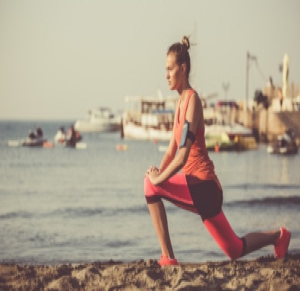Since our world has been transformed into sitting most of the time it is inevitable that our hip flexors become tight. Many people sit during the day, whether it is due to taking a break from standing, sitting working at a desk, sitting in a car, relaxing on a couch, this all leads to your hip flexors being in a shortened position and keeping them in this shortened position results in them becoming tight. This is why hip stretches and strengthening is so important to add to your exercise routine.
So what if my hip flexors are tight?
Having tight hip flexors can lead to discomfort. Having tight hip flexors may result in injury as your body isn’t aligned. Luckily, working on your hip flexor’s mobility can keep those injuries at bay.
What are hip flexors?
Your hip flexors are made up of iliacus, psoas major, and the rectus femoris. These muscles are anteriorly (front) near the top of your thighs. They are the key players in your lower body as they let you kick, bend, walk and swivel your hips. When they are too tight it can tear or stretch when you make a sudden movement.
Can my painful lower back be a result of tight hip flexors?
Our body has been wonderfully made and everything interlinks. One ache here can lead to another painful spot elsewhere. All muscles are attached to bones. When you tug on a muscles the result is that the bone gets tugged as well.
Our back muscles span from our neck to our legs at the hip. When our hip flexors are tight it limits our range of movement at our hips. This makes it hard for your hips to rotate and therefore causes the lower back to compensate. So basically, tugging at the hip caused by the hip flexors results in the back to tug as the back muscles are attached at the hip.
When one muscle is tight it results in the opposite muscle not to be able to activate as it is placed in a stretched position. Since we know that the hip flexors are tight, in the front of our hips, what happens at the back of our hips? Posteriorly, otherwise known as the back, is a group of muscles named glutes. This is like a seesaw affect as they are opposing muscle groups. When one is more lengthened than the optimal length (glutes) due to the hip flexors being tight, it results in it being harder for your glutes to contract. Since the glutes are contracting sufficiently it causes other muscles to do more work. This can increase your risk of injury as other muscles are placed with too much demand and your workout can be less efficient.
Lengthened glutes in return make you more quad dominant and then your hamstrings become weaker which have a knock on effect on your knees and so on. When your glutes aren’t activating and your hips aren’t mobile, it also impacts your impact absorption. On the contrary, having strong glutes create the anchor for your pelvis which plays a big role in your alignment and movement.
Let’s compare two types of exercise, one being a squat and the other one being a squat jump, a plyometric movement. To be able to do a squat you require hip mobility for the hip to allow for flexion, rotate inwards and then rotate outwards. When you do a squat jump you have the same movement but more demand on your hips as it needs stability. The quicker your hips, knees and ankles can bend the better it is to absorb the impact from the ground as you land. This is why mobility and strength is so important.
Benefits of hip stretches
To be mobile it is very important to stretch. This increases the length of the muscles and works towards more mobility. When the muscles are at their optimal length it allows the muscles to contract optimally therefore gaining strength.
Some exercises are directly stretching the hip flexors while others stretch the surrounding muscles such as your glutes which are just as important.
- Relieve discomfort
- Decrease tightness
- Increase mobility
These stretches don’t have to take you long. It can be as short as only spending 10min a day or you can even incorporate it in your existing program to improve mobility in your hips.
Stretches:
Lunge Twist
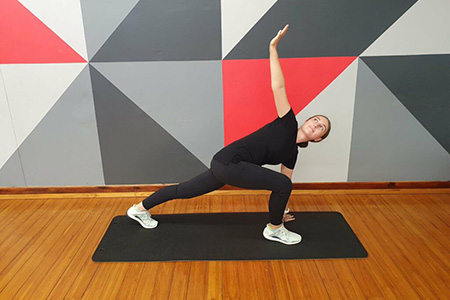
This stretch is aimed at stretching your hip flexors, back and quads.
How to do it:
- Stand comfortably
- Take a big step forward with one leg
- Bend your knee of your leg you just stepped forwards with and drop down into a lunge. Ensure your back leg is straight.
- Reach up to the sky with your arm that is on the same sided leg that you stepped forwards with. Put your opposite hand on the floor for support.
- Repeat on the other side.
Dosage: Hold for 30 seconds and progress to 2 minutes.
High Crescent Lunge
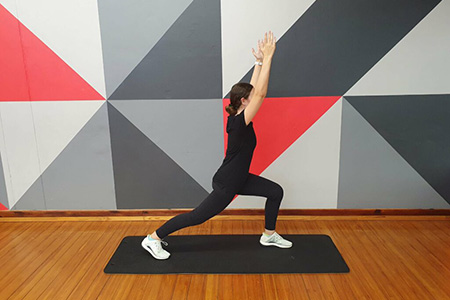
This stretch is aimed at stretching your hip flexors and quads.
How to do it:
- Stand comfortably
- Take a big step forward with one leg
- Bend your knee of your leg you just stepped forwards with and drop down into a lunge. Ensure your back leg is straight.
- Try keep your hips in line with one another
- Lift your arms toward the roof and stretch up.
Dosage: Hold the stretch for 5 breaths and then swap legs.
Knee-to-Chest Stretch
This stretch is aimed on stretching your lower back, hips and hamstrings.
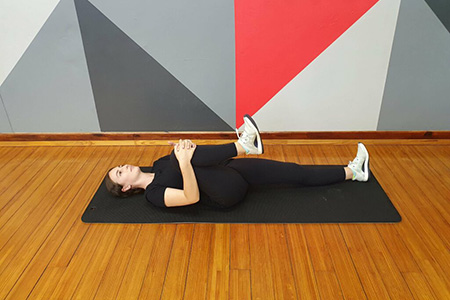
How to do it:
- Lie on your back
- Bring one knee into your hands and gently use your arms to bend your knee towards your chest
- Keep your back pressed into the floor
Dosage: Hold for 30 seconds and progress to 2 minutes and switch legs.
90/90 Hip Stretch
This stretch is aimed at stretching your hips.
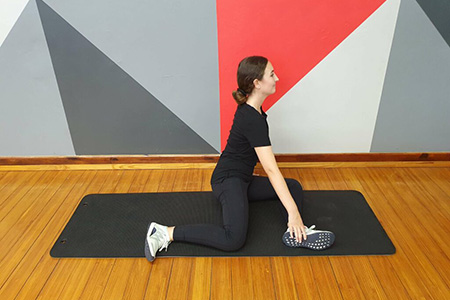
How to do it:
- Sit on the floor
- Place your front leg in a 90 degree angle directly out in front of you with your knee flat on the ground and your foot flexed.
- Do the same with the leg behind you.
- Put your hands either side of you on the floor.
- Try keep both buttocks on the ground.
Dosage: Hold for 30 and progress to 2 minutes and stretch alternative leg.
Note:
For a progression, slowly bring your chest towards your front leg, keeping your shoulders square.
Figure Four Stretch
This stretch is aimed at stretching your lower back, hips, glutes and hamstrings.
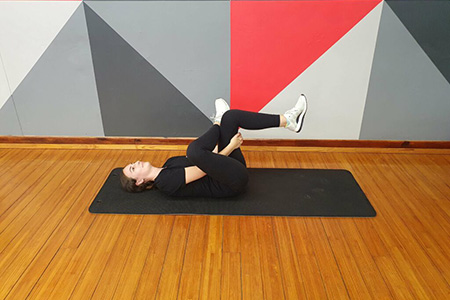
How to do it:
- Lie on your back
- Bend both your knees
- Cross your one foot over the opposite leg’s quad causing your knee to bend sideways
- Gently hold and pull your leg that is still on the ground towards your chest
Dosage: Hold for 30 seconds and progress to 2 minutes and stretch your other leg.
Reclining Bound Angle Pose
This stretch is aimed at stretching your inner thigh, hips and groin.
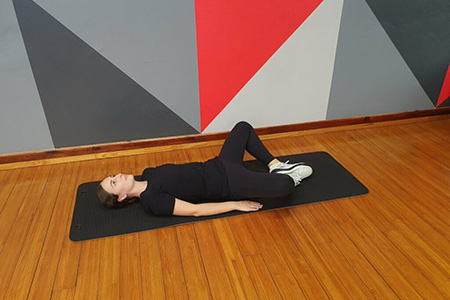
How to do it:
- Lie on your back
- Bend your knees outwards and bring the souls of your shoes together
- Try stretch your knees down towards the floor
Dosage: Hold for 30 seconds and progress to 2 minutes
Piriformis stretch
This stretch aims to stretch your back, hips and glutes.
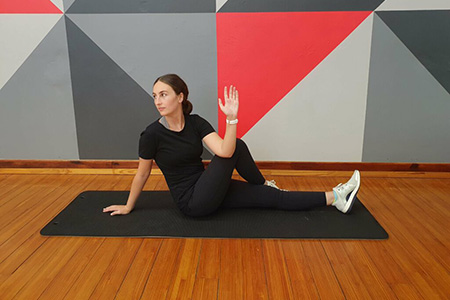
How to do it:
- Sit on the floor while both of your legs extended
- Cross your one leg over the other and place your foot flat on the ground close to your knee
- Use your one hand for support on the ground and the other as a lever to pull your bent knee to the opposite hip using your elbow.
Dosage: Hold for 30 seconds and progress to 2 minutes and stretch your other leg.
Note:
If step 3 hurts your back, you don’t have to do the spinal twist but rather just pull your knee with your hands
Cow Face Pose
This aims to stretch your hip abductors.
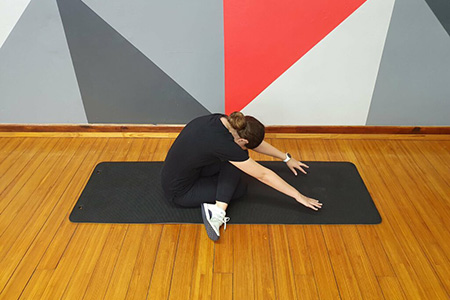
How to do it:
- Positioned on your hands and knees
- Cross your one leg in front of the other so that your knees are in one line
- Slowly sit backwards in between your feet. If both hips aren’t in line, sit on a blanket or block
Dosage: Hold for 5 breaths and then repeat on the other side
Note:
To progress, extend your arms out in front of you and press your palms into the mat.
Three-legged Dog
This stretch is aimed at stretching your shoulders, back, hips and hamstrings.
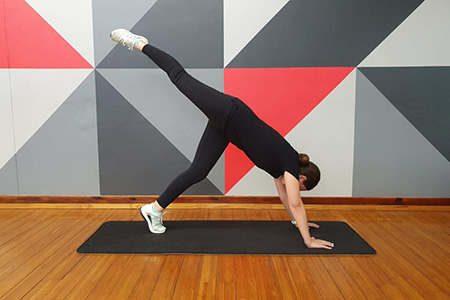
How to do it:
- With your feet hip-width apart, place yourself in a Downward Facing Dog position
- Lift one leg off the floor and extend it as high as you can
Dosage: Hold for 15 to 30 seconds and switch legs.
Note:
To progress, alternate between pointing and flexing your foot to vary your stretch
Kneeling Side Bend Stretch
This stretch is aimed at stretching your obliques, hips, groin and inner thigh.
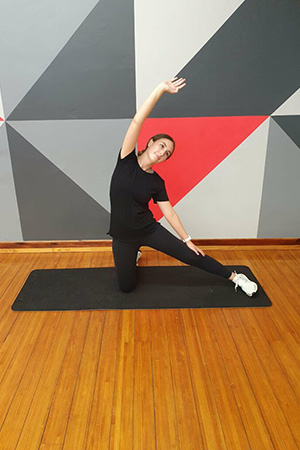
How to do it:
- Kneel on the floor
- Keep your back straight and core tight
- Extend your one leg out to the same side. Make sure your leg is in line with your body.
- Slowly bend your trunk towards the outstretched leg. Place your one hand on your leg for support and the other over your head towards your outstretched leg.
- Make sure your hips are square.
Dosage: Hold for 30 seconds to 2 minutes and repeat on the other side.
Lunging Hip Flexor Stretch
This stretched is aimed at stretching your hips, quads and glutes.
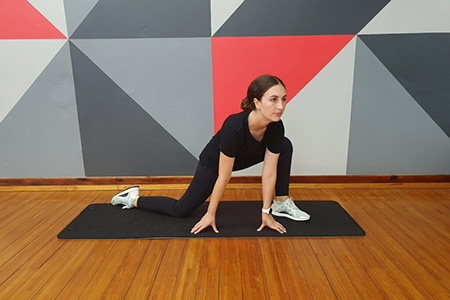
How to do it:
- Stand with your feet shoulder width apart
- Take a step back and place your one knee on the floor
- Lean forward slightly to feel your hip stretch
- Squeeze your buttocks to increase the intensity of the stretch.
Dosage: Hold for 30 seconds to 2 minutes and repeat on the other side.
Lunging Hip Flexor Stretch With Rotation
This stretch is aimed at stretching your hips, glutes and quads.

How to do it:
- Stand with your feet shoulder width apart
- Take a step back and place your one knee on the floor behind your other leg
- Lean forward slightly to feel your hip stretch
- Squeeze your buttocks to increase the intensity of the stretch
- Rotate your upper body to open your torso and put your hands in front of your knees
Dosage: Hold for 30 seconds to 2 minutes and switch sides.
Happy Baby Pose Stretch
This stretch is used to stretch your hip adductors.
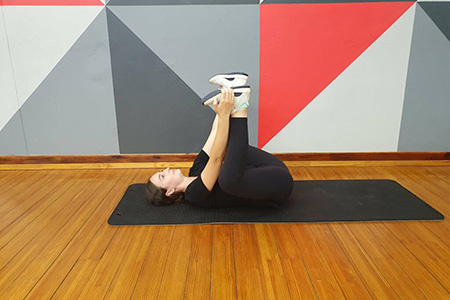
How to do it:
- Lie on your back
- Bend both knees as far as you can go
- Gently pull your feet towards your chest and let your knees lower towards the ground
- Keep your back flat on the ground
Dosage: Hold for 5 breaths
Pretzel Stretch
This stretch is aimed at stretching your back, obliques, hips and glutes.
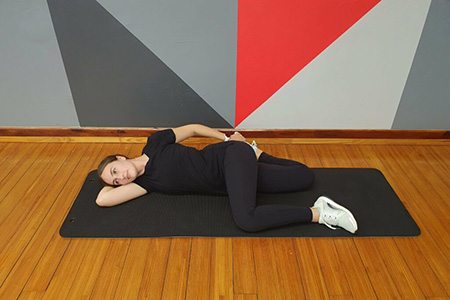
How to do it:
- Lie on your side with your head resting on your arm
- Bend your knee of your leg that is on top and bring it towards your chest and place it on the floor
- Bend your knee of the bottom leg towards your buttock while keeping your thigh in line with your upper bottom
- Rotate your torso open so that your upper shoulder blade goes backwards and to the ground
Dosage: Hold for 30 seconds to 2 minutes and stretch the other side
Note:
To progress, turn your head to look over the shoulder you brought to the ground
Twisted Reclined Pigeon
This stretch is aimed at stretching your lower back, hips and glutes.
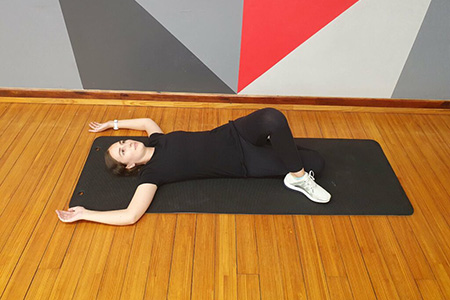
How to do it:
- Lie on your back with your feel flat on the floor and arms out to your sides in a cactus formation
- Bend one knee and place that foot over the opposite leg by your knee
- Bend your bottom knee and place your foot by your opposite buttock or higher
Dosage: Hold for 30 seconds to 2 minutes and change sides and repeat.
Bridge Pose
This exercise is aimed at strengthening your glutes, which takes the pressure off your hip muscles.
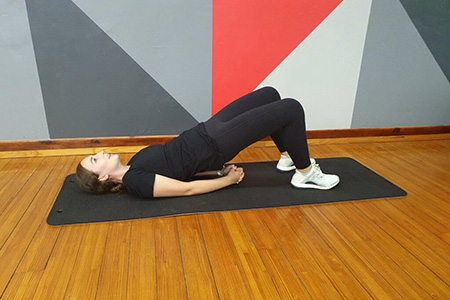
How to do it:
- Lie on your back
- Bend your knees and place your feet hip width apart on the floor and ensure your feet are under your knees
- Contract your stomach muscles and buttocks and push your buttocks up into the sky so that you form a straight line from your knees to shoulders
- Interlace your fingers underneath your body and press them down into the mat
Dosage: Hold for at least 5 breaths
About Dr. Bagwe
Dr. Bagwe is a leading orthopedic surgeon specializing in ankle and foot reconstruction. If you are looking for an orthopedic surgeon near you then look no further. Dr. Bagwe is an industry leader when it comes to foot and ankle surgery doctors in St. Louis. Dr. Bagwe and his friendly and professional team is ready to welcome you and tell you everything you need to know.
Reach out and contact us today.

